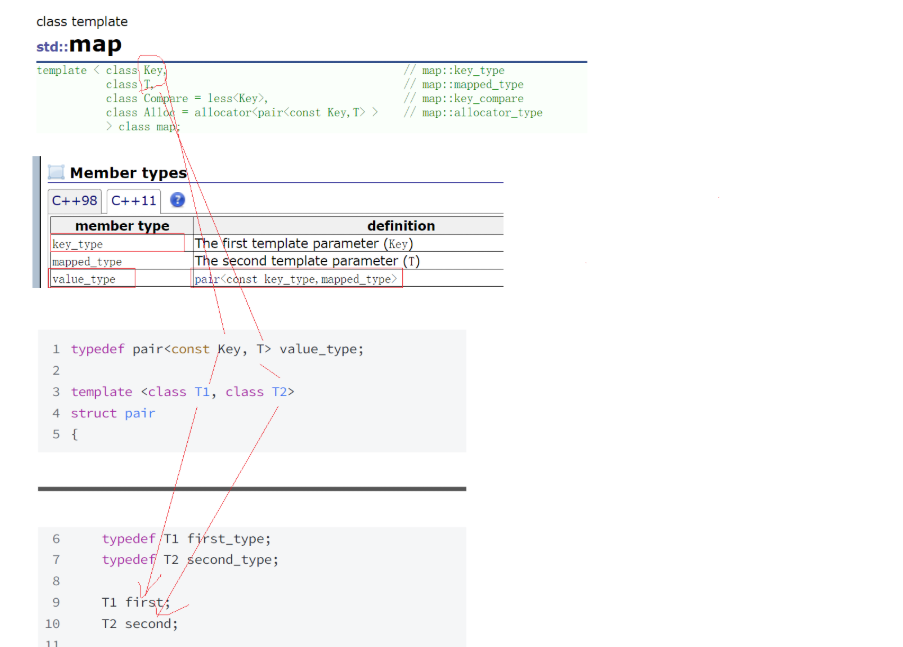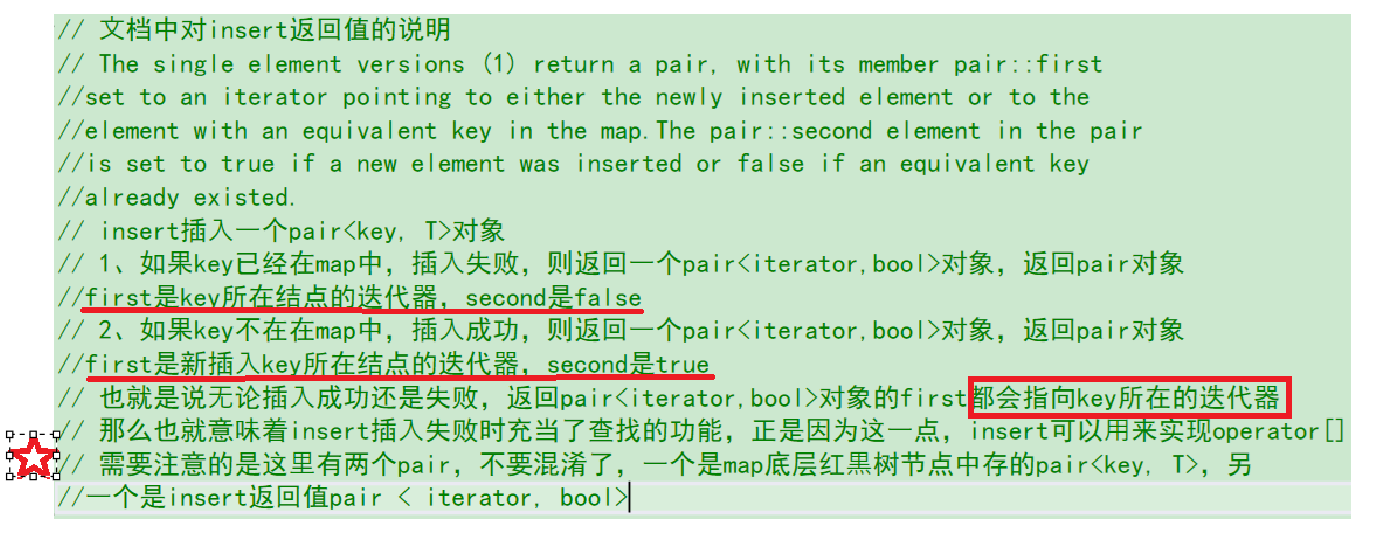map和set的使⽤
1. 序列式容器和关联式容器
前⾯我们已经接触过STL中的部分容器如:string、vector、list、deque、array、forward_list等,这些容器统称为序列式容器,因为逻辑结构为线性序列的数据结构,两个位置存储的值之间⼀般没有紧密的关联关系,⽐如交换⼀下,他依旧是序列式容器。顺序容器中的元素是按他们在容器中的存储位置来顺序保存和访问的。
关联式容器也是⽤来存储数据的,与序列式容器不同的是,关联式容器逻辑结构通常是⾮线性结构, 两个位置有紧密的关联关系,交换⼀下,他的存储结构就被破坏了。顺序容器中的元素是按关键字来 保存和访问的。关联式容器有map/set系列和unordered_map/unordered_set系列。 本文讲解的map和set底层是红⿊树,红⿊树是⼀颗平衡⼆叉搜索树。set是key搜索场景的结构, map是key/value搜索场景的结构。
2. set系列的使⽤
2.1 set和multiset参考⽂档
<set> - C++ Reference
2.2 set类的介绍
template < class T, // set::key_type/value_typeclass Compare = less<T>, // set::key_compare/value_compareclass Alloc = allocator<T> // set::allocator_type
> class set;• set的声明如下,T就是set底层关键字的类型。
• set默认要求T⽀持⼩于⽐较,如果不⽀持或者想按⾃⼰的需求⾛可以⾃⾏实现仿函数传给第⼆个模版参数。
• set底层存储数据的内存是从空间配置器申请的,如果需要可以⾃⼰实现内存池,传给第三个参
数。
• ⼀般情况下,我们都不需要传后两个模版参数。
• set底层是⽤红⿊树实现,增删查效率是 ,迭代器遍历是⾛的搜索树的中序,所以是有序
的。 O(logN)
• 前⾯部分我们已经学习了vector/list等容器的使⽤,STL容器接⼝设计高度相似。
2.3 set的构造和迭代器
set的⽀持正向和反向迭代遍历,遍历默认按升序顺序,因为底层是⼆叉搜索树(红黑树是一种特殊的二叉搜索树),迭代器遍历⾛的中序;⽀持迭代器就意味着⽀持范围for,set的iterator和const_iterator都不⽀持迭代器修改数据,修改关键字数据,破坏了底层搜索树的结构。
// empty (1) ⽆参默认构造
explicit set(const key_compare& comp = key_compare(),const allocator_type& alloc = allocator_type());
// range (2) 迭代器区间构造
template <class InputIterator>
set(InputIterator first, InputIterator last,const key_compare& comp = key_compare(),const allocator_type & = allocator_type());
// copy (3) 拷⻉构造
set(const set& x);
// initializer list (5) initializer 列表构造
set(initializer_list<value_type> il,const key_compare& comp = key_compare(),const allocator_type& alloc = allocator_type());
// 迭代器是⼀个双向迭代器
iterator->a bidirectional iterator to const value_type
// 正向迭代器
iterator begin();
iterator end();
// 反向迭代器
reverse_iterator rbegin();
reverse_iterator rend();2.4 set的增删查
set的增删查关注以下⼏个接⼝即可:
Member types
key_type->The first template parameter(T)
value_type->The first template parameter(T)// 单个数据插⼊,如果已经存在则插⼊失败
pair<iterator, bool> insert(const value_type& val);
// 列表插⼊,已经在容器中存在的值不会插⼊
void insert(initializer_list<value_type> il);
// 迭代器区间插⼊,已经在容器中存在的值不会插⼊
template <class InputIterator>
void insert(InputIterator first, InputIterator last);
// 查找val,返回val所在的迭代器,没有找到返回end()
iterator find(const value_type& val);
// 查找val,返回Val的个数
size_type count(const value_type& val) const;
// 删除⼀个迭代器位置的值
iterator erase(const_iterator position);
// 删除val,val不存在返回0,存在返回1
size_type erase(const value_type& val);
// 删除⼀段迭代器区间的值
iterator erase(const_iterator first, const_iterator last);
// 返回⼤于等于val位置的迭代器
iterator lower_bound(const value_type& val) const;
// 返回⼤于val位置的迭代器
iterator upper_bound(const value_type& val) const;2.5 insert和迭代器遍历使⽤样例:
#include<iostream>
#include<set>
using namespace std;
int main()
{// 去重+升序排序set<int> s;// 去重+降序排序(给⼀个⼤于的仿函数)//set<int, greater<int>> s;s.insert(5);s.insert(2);s.insert(7);s.insert(5);//set<int>::iterator it = s.begin();auto it = s.begin();while (it != s.end()){ // error C3892: “it”: 不能给常量赋值// *it = 1;cout << *it << " ";++it;}cout << endl;// 插⼊⼀段initializer_list列表值,已经存在的值插⼊失败s.insert({ 2,8,3,9 });for (auto e : s){cout << e << " ";}cout << endl;set<string> strset = { "sort", "insert", "add" };// 遍历string⽐较ascll码⼤⼩顺序遍历的for (auto& e : strset){cout << e << " ";}cout << endl;
}
//运行结果:
//2 5 7
//2 3 5 7 8 9
//add insert sort2.6 find和erase使⽤样例:
#include<iostream>
#include<set>
using namespace std;
int main()
{// 去重+升序排序set<int> s = { 4,2,7,2,8,5,9 };for (auto e : s){cout << e << " ";}cout << endl;// 删除最⼩值s.erase(s.begin());for (auto e : s){cout << e << " ";}cout << endl;// 直接删除xint x;cin >> x;int num = s.erase(x);if (num == 0){cout << x << "不存在!" << endl;}for (auto e : s){cout << e << " ";}cout << endl;// 直接查找在利⽤迭代器删除xcin >> x;auto pos = s.find(x);if (pos != s.end()){s.erase(pos);}else{cout << x << "不存在!" << endl;}for (auto e : s){cout << e << " ";}cout << endl;// 算法库的查找 O(N)auto pos1 = find(s.begin(), s.end(), x);// set⾃⾝实现的查找 O(logN)auto pos2 = s.find(x);// 利⽤count间接实现快速查找cin >> x;if (s.count(x)){cout << x << "在!" << endl;}else{cout << x << "不存在!" << endl;}return 0;
}#include<iostream>
#include<set>
using namespace std;
int main()
{set<int> myset;for (int i = 1; i < 10; i++)myset.insert(i * 10); // 10 20 30 40 50 60 70 80 90for (auto e : myset){cout << e << " ";}cout << endl;// 实现查找到的[itlow,itup)包含[30, 60]区间// 返回 >= 30auto itlow = myset.lower_bound(30);// 返回 > 60auto itup = myset.upper_bound(60);// 删除这段区间的值myset.erase(itlow, itup);for (auto e : myset){cout << e << " ";}cout << endl;return 0;
}2.7 multiset和set的差异
multiset和set的使⽤基本完全类似,主要区别点在于multiset⽀持值冗余,那么insert/find/count/erase都围绕着⽀持值冗余有所差异,具体参看下⾯的样例代码理解。
#include<iostream>
#include<set>
using namespace std;
int main()
{// 相⽐set不同的是,multiset是排序,但是不去重multiset<int> s = { 4,2,7,2,4,8,4,5,4,9 };auto it = s.begin();while (it != s.end()){cout << *it << " ";++it;}cout << endl;// 相⽐set不同的是,x可能会存在多个,find查找中序的第⼀个int x;cin >> x;auto pos = s.find(x);while (pos != s.end() && *pos == x){cout << *pos << " ";++pos;}cout << endl;// 相⽐set不同的是,count会返回x的实际个数cout << s.count(x) << endl;// 相⽐set不同的是,erase给值时会删除所有的xs.erase(x);for (auto e : s){cout << e << " ";}cout << endl;return 0;
}2.8 OJ题目
349. 两个数组的交集 - 力扣(LeetCode)
class Solution {
public:vector<int> intersection(vector<int>& nums1, vector<int>& nums2) {set<int> s1(nums1.begin(),nums1.end());// 1 2set<int> s2(nums2.begin(),nums2.end());// 2// 因为set遍历是有序的,有序值,依次⽐较// ⼩的++,相等的就是交集vector<int> ret;auto it1 = s1.begin();auto it2 = s2.begin();while(it1 != s1.end() && it2 != s2.end()){if(*it1 < *it2){it1++;}else if(*it1 > *it2){it2++;}else{ret.push_back(*it1);it1++;it2++;}}return ret;}
};142. 环形链表 II - 力扣(LeetCode)
/*** Definition for singly-linked list.* struct ListNode {* int val;* ListNode *next;* ListNode(int x) : val(x), next(NULL) {}* };*/
class Solution {
public:ListNode *detectCycle(ListNode *head){set<ListNode*> s;ListNode* cur = head; while(cur){auto ret = s.insert(cur);if(ret.second == false)return cur;cur = cur->next;}return nullptr;}
};3. map系列的使⽤
3.1 map和multimap参考⽂档
<map> - C++ Reference
3.2 map类的介绍
map的声明如下,Key就是map底层关键字的类型,T是map底层value的类型,map默认要求Key⽀持⼩于⽐较,如果不⽀持或者需要的话可以⾃⾏实现仿函数传给第⼆个模版参数,map底层存储数据的内存是从空间配置器申请的。⼀般情况下,我们都不需要传后两个模版参数。map底层是⽤红⿊树实现,增删查改效率是 O(logN) ,迭代器遍历是⾛的中序,所以是按key有序顺序遍历的。
template < class Key, // map::key_typeclass T, // map::mapped_typeclass Compare = less<Key>, // map::key_compareclass Alloc = allocator<pair<const Key, T> > //map::allocator_type
> class map;3.3 pair类型介绍
map底层的红⿊树节点中的数据,使⽤pair<Key, T>存储键值对数据。
typedef pair<const Key, T> value_type;
template <class T1, class T2>
struct pair
{typedef T1 first_type;typedef T2 second_type;T1 first;T2 second;pair() : first(T1()), second(T2()){}pair(const T1& a, const T2& b) : first(a), second(b){}template<class U, class V>pair(const pair<U, V>& pr) : first(pr.first), second(pr.second){}
};
template <class T1, class T2>
inline pair<T1, T2> make_pair(T1 x, T2 y)
{return (pair<T1, T2>(x, y));
}
3.4 map的构造
map的构造我们关注以下⼏个接⼝即可。
map的⽀持正向和反向迭代遍历,遍历默认按key的升序顺序,因为底层是⼆叉搜索树,迭代器遍历⾛的中序;⽀持迭代器就意味着⽀持范围for,map⽀持修改value数据,不⽀持修改key数据,修改关键字数据,破坏了底层搜索树的结构。
// empty (1) ⽆参默认构造
explicit map(const key_compare& comp = key_compare(),const allocator_type& alloc = allocator_type());
// range (2) 迭代器区间构造
template <class InputIterator>
map(InputIterator first, InputIterator last,const key_compare& comp = key_compare(),const allocator_type & = allocator_type());
// copy (3) 拷⻉构造
map(const map& x);
// initializer list (5) initializer 列表构造
map(initializer_list<value_type> il,const key_compare& comp = key_compare(),const allocator_type& alloc = allocator_type());
// 迭代器是⼀个双向迭代器
iterator->a bidirectional iterator to const value_type
// 正向迭代器
iterator begin();
iterator end();
// 反向迭代器
reverse_iterator rbegin();
reverse_iterator rend();3.5 map的增删查
map的增删查关注以下⼏个接⼝即可:
map接⼝,插⼊的pair键值对数据,跟set所有不同,但是查和删的接⼝只⽤关键字key跟set是完全类似的,不过find返回iterator,不仅仅可以确认key在不在,还找到key映射的value,同时通过迭代还可以修改value。
Member types
key_type->The first template parameter(Key)
mapped_type->The second template parameter(T)
value_type->pair<const key_type, mapped_type>//相当于把key和value打包成一个结构体插入
// 单个数据插⼊,如果已经key存在则插⼊失败,key存在相等value不相等也会插⼊失败
pair<iterator, bool> insert(const value_type& val);
// 列表插⼊,已经在容器中存在的值不会插⼊
void insert(initializer_list<value_type> il);
// 迭代器区间插⼊,已经在容器中存在的值不会插⼊
template <class InputIterator>
void insert(InputIterator first, InputIterator last);
// 查找k,返回k所在的迭代器,没有找到返回end()
iterator find(const key_type& k);
// 查找k,返回k的个数
size_type count(const key_type& k) const;
// 删除⼀个迭代器位置的值
iterator erase(const_iterator position);
// 删除k,k存在返回0,存在返回1
size_type erase(const key_type& k);
// 删除⼀段迭代器区间的值
iterator erase(const_iterator first, const_iterator last);
// 返回⼤于等于k位置的迭代器
iterator lower_bound(const key_type& k);
// 返回⼤于k位置的迭代器
const_iterator lower_bound(const key_type& k) const;3.6 map的数据修改
前⾯我提到map⽀持修改mapped_type 数据,不⽀持修改key数据,修改关键字数据,破坏了底层搜索树的结构。
map第⼀个⽀持修改的⽅式是通过迭代器,迭代器遍历时或者find返回key所在的iterator,修改map 还有⼀个⾮常重要的修改接⼝operator[],但是operator[]不仅仅⽀持修改,还⽀持插⼊数据和查找数据,所以他是⼀个多功能复合接口。
需要注意从内部实现⻆度,map这⾥把我们传统说的value值,给的是T类型,typedef为 mapped_type。⽽value_type是红⿊树结点中存储的pair键值对值。⽇常使⽤我们还是习惯将这⾥的T映射值叫做value。
Member types
key_type->The first template parameter(Key)
mapped_type->The second template parameter(T)
value_type->pair<const key_type, mapped_type>
// 查找k,返回k所在的迭代器,没有找到返回end(),
//如果找到了通过iterator可以修改key对应的mapped_type值
iterator find(const key_type& k);pair<iterator, bool> insert(const value_type & val);
mapped_type& operator[] (const key_type& k);
// operator的内部实现
mapped_type& operator[] (const key_type& k)
{// 1、如果k不在map中,insert会插⼊k和mapped_type默认值,同时[]返回结点中存储//mapped_type值的引⽤,那么我们可以通过引⽤修改返映射值。所以[]具备了插⼊ + 修改功能// 2、如果k在map中,insert会插⼊失败,但是insert返回pair对象的first是指向key结点的//迭代器,返回值同时[]返回结点中存储mapped_type值的引⽤,所以[]具备了查找 + 修改的功能pair<iterator, bool> ret = insert({ k, mapped_type() });iterator it = ret.first;return it->second;
}
3.7 构造遍历及增删查使⽤样例
#include<iostream>
#include<map>
using namespace std;
int main()
{// initializer_list构造及迭代遍历map<string, string> dict = { {"left", "左边"}, {"right", "右边"},{"insert", "插⼊"},{ "string", "字符串" } };//map<string, string>::iterator it = dict.begin();auto it = dict.begin();while (it != dict.end()){//cout << (*it).first <<":"<<(*it).second << endl;// map的迭代基本都使⽤operator->,这⾥省略了⼀个->// 第⼀个->是迭代器运算符重载,返回pair*,第⼆个箭头是结构指针解引⽤取pair数据//cout << it.operator->()->first << ":" << it.operator->()-> second << endl;cout << it->first << ":" << it->second << endl;++it;}cout << endl;// insert插⼊pair对象的4种⽅式,对⽐之下,最后⼀种最⽅便pair<string, string> kv1("first", "第⼀个");dict.insert(kv1);dict.insert(pair<string, string>("second", "第⼆个"));dict.insert(make_pair("sort", "排序"));dict.insert({ "auto", "⾃动的" });// "left"已经存在,插⼊失败dict.insert({ "left", "左边,剩余" });// 范围for遍历for (const auto& e : dict){cout << e.first << ":" << e.second << endl;}cout << endl;string str;while (cin >> str){auto ret = dict.find(str);if (ret != dict.end()){cout << "->" << ret->second << endl;}else{cout << "⽆此单词,请重新输⼊" << endl;}}// erase等接⼝跟set完全类似,这⾥就不演⽰讲解了return 0;
}3.8 map的迭代器和[]功能样例:
#include<iostream>
#include<map>
#include<string>
using namespace std;
int main()
{ // 利⽤find和iterator修改功能,统计⽔果出现的次数string arr[] = { "苹果", "西⽠", "苹果", "西⽠", "苹果", "苹果", "西⽠","苹果", "⾹蕉", "苹果", "⾹蕉" };map<string, int> countMap;for (const auto& str : arr){// 先查找⽔果在不在map中// 1、不在,说明⽔果第⼀次出现,则插⼊{⽔果, 1}// 2、在,则查找到的节点中⽔果对应的次数++auto ret = countMap.find(str);if (ret == countMap.end()){countMap.insert({ str, 1 });}else{ret->second++;}}for (const auto& e : countMap){cout << e.first << ":" << e.second << endl;}cout << endl;return 0;
}#include<iostream>
#include<map>
#include<string>
using namespace std;
int main()
{// 利⽤[]插⼊+修改功能,巧妙实现统计⽔果出现的次数string arr[] = { "苹果", "西⽠", "苹果", "西⽠", "苹果", "苹果", "西⽠","苹果", "⾹蕉", "苹果", "⾹蕉" };map<string, int> countMap;for (const auto& str : arr){// []先查找⽔果在不在map中// 1、不在,说明⽔果第⼀次出现,则插⼊{⽔果, 0},同时返回次数的引⽤,++⼀下就变成1次了// 2、在,则返回⽔果对应的次数++countMap[str]++;}for (const auto& e : countMap){cout << e.first << ":" << e.second << endl;}cout << endl;return 0;
}#include<iostream>
#include<map>
#include<string>
using namespace std;
int main()
{map<string, string> dict;dict.insert(make_pair("sort", "排序"));// key不存在->插⼊ {"insert", string()}dict["insert"];// 插⼊+修改dict["left"] = "左边";// 修改dict["left"] = "左边、剩余";// key存在->查找cout << dict["left"] << endl;return 0;
}3.9 multimap和map的差异
multimap和map的使⽤基本完全类似,主要区别点在于multimap⽀持关键值key冗余,那么
insert/find/count/erase都围绕着⽀持关键值key冗余有所差异,这⾥跟set和multiset完全⼀样,⽐如find时,有多个key,返回中序第⼀个。其次就是multimap不⽀持[],因为⽀持key冗余,[]就只
能⽀持插⼊了,不能⽀持修改。
能⽀持插⼊了,不能⽀持修改。
3.10 OJ题目
138. 随机链表的复制 - 力扣(LeetCode)
直接让{原结点,拷⻉结点}建⽴映射关系放到map中,控制随机指针会⾮常简单⽅便。
/*
// Definition for a Node.
class Node {
public:int val;Node* next;Node* random;Node(int _val) {val = _val;next = NULL;random = NULL;}
};
*/class Solution {
public:Node* copyRandomList(Node* head) {Node* copyhead =nullptr;Node* copytail =nullptr;map<Node*,Node*> Nodemap;Node* cur =head;while(cur){if(copytail == nullptr){copyhead = copytail = new Node(cur->val);}else{copytail->next = new Node(cur->val);copytail =copytail->next;}//让{原结点,拷⻉结点}建⽴映射关系Nodemap[cur] = copytail;cur = cur->next;}cur = head;Node* copy =copyhead;while(cur){if(cur->random == nullptr){copy->random = nullptr;}else{copy->random = Nodemap[cur->random];}cur = cur ->next;copy = copy ->next;}return copyhead;}
};692. 前K个高频单词 - 力扣(LeetCode)
class Solution {
public:vector<string> topKFrequent(vector<string>& words, int k) {//计数map<string ,int> countmap;for(auto& e: words){countmap[e]++;}vector<pair<string,int>> top(countmap.begin(),countmap.end());stable_sort(top.begin(),top.end(),[](const pair<string, int>& s1,const pair<string,int>& s2){return s1.second > s2.second;});//取前k个vector<string> ret;for(int i = 0 ;i < k ;i++){ret.push_back(top[i].first);}return ret;}
};class Solution {
public:struct Compare{bool operator()(const pair<string, int>& s1,const pair<string,int>& s2) const{return s1.second > s2.second;}};vector<string> topKFrequent(vector<string>& words, int k) {//计数map<string ,int> countmap;for(auto& e: words){countmap[e]++;}vector<pair<string,int>> top(countmap.begin(),countmap.end());stable_sort(top.begin(),top.end(),Compare());//取前k个vector<string> ret;for(int i = 0 ;i < k ;i++){ret.push_back(top[i].first);} return ret;}
};class Solution {
public:struct Compare{bool operator()(const pair<string, int>& x, const pair<string, int>& y)const{// 要注意优先级队列底层是反的,⼤堆要实现⼩于⽐较,所以这⾥次数相等,想要字典序⼩的在前⾯要⽐较字典序⼤的为真return x.second < y.second || (x.second == y.second && x.first > y.first);}};vector<string> topKFrequent(vector<string>& words, int k) {map<string, int> countMap;for (auto& e : words){countMap[e]++;}// 将map中的<单词,次数>放到priority_queue中,仿函数控制⼤堆,次数相同按照字典序规则排序priority_queue<pair<string, int>, vector<pair<string, int>>, Compare>p(countMap.begin(), countMap.end());vector<string> strV;for (int i = 0; i < k; ++i){strV.push_back(p.top().first);p.pop();}return strV;}
};